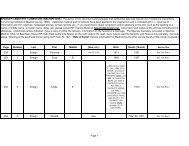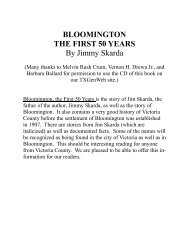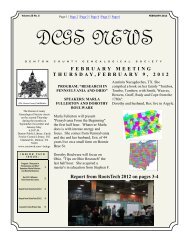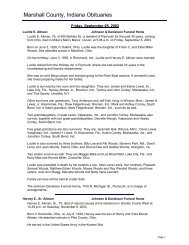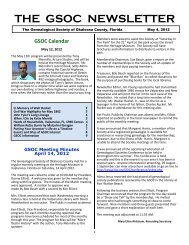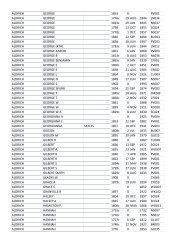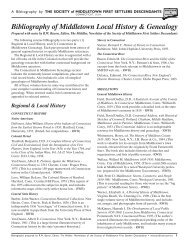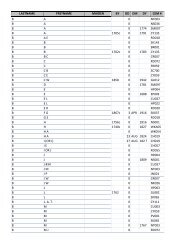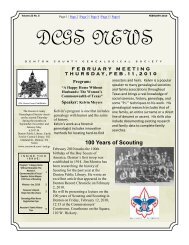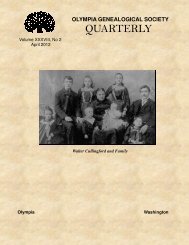June 1996 Newsletter [v5.0] - RootsWeb
June 1996 Newsletter [v5.0] - RootsWeb
June 1996 Newsletter [v5.0] - RootsWeb
You also want an ePaper? Increase the reach of your titles
YUMPU automatically turns print PDFs into web optimized ePapers that Google loves.
subsistence.<br />
Typical of the Landskroner village of the era was<br />
Ober Johnsdorf (Horní Tresnovec), located just<br />
north of the town of Landskron. Ober Johnsdorf<br />
contained about 1,000 inhabitants in the 1850s,<br />
most of them German-speaking but with a<br />
significant Czech-speaking minority. The<br />
neighboring villages to the north, Cermná and<br />
Nepomuky (Nepomuk), were predominantly<br />
Czech. The other nearby villages, Jokelsdorf<br />
(Jakubovice), Michelsdorf (Ostrov), and Nieder<br />
Johnsdorf (Dolní Tresnovec), were predominantly<br />
German. Ober Johnsdorf was comprised of 1,108<br />
hectares, which is about four and one-quarter<br />
sections of land, or 2,738 acres.<br />
The average landholding in Ober Johnsdorf was<br />
about seven and a half hectares, with over half<br />
the farms smaller than five hectares. Only a<br />
dozen farms had more than 20 hectares. Since the<br />
town of Landskron was three miles distant, it is<br />
likely that excess grain from Ober Johnsdorf was<br />
transported by horse or ox-cart for shipment by<br />
rail to the cities of the Austrian Empire. Apart<br />
from farming, Ober Johnsdorf in the early 1850s<br />
had no church and only a basic school. For church<br />
services and any advanced schooling, Ober<br />
Johnsdorf's villagers traveled to Landskron-town.<br />
Given the limited educational opportunities<br />
available at the time, many of Ober Johnsdorf's<br />
inhabitants had only primitive reading and<br />
writing skills.<br />
In sharp contrast to farming in America,<br />
Landskron-district farmsteads were not separate<br />
from its villages. Farm buildings were located on<br />
both sides of a road, and farm fields stretched<br />
straight back from the buildings until they<br />
bordered another village's farms. Farms might<br />
also end at the woods or at an untillable hill.<br />
Generally, farmers in Ober Johnsdorf cultivated<br />
contiguous fields, unlike the practice in other<br />
areas of Europe. It could, however, be a<br />
considerable distance from the farm buildings to<br />
each farm's property limits. Also, farmland that<br />
was wooded or low provided natural barriers<br />
separating tillable parcels within the farm.<br />
Ober Johnsdorf's farm buildings also showed a<br />
distinctive configuration. Generally, the living<br />
quarters were physically connected to the farm<br />
buildings. More elaborate farmsteads were set up<br />
in a U-shape or square with a courtyard in the<br />
8<br />
middle. The latter square form probably<br />
developed in an attempt to provide some<br />
protection against thieves and foreign soldiers,<br />
and it also allowed the farmer to secure his<br />
animals and harvested crops from marauding<br />
animals.<br />
The Push to Emigrate<br />
The families of the prospective emigrants to<br />
America had lived in the Landskron district for<br />
hundreds of years. Up until 1848, the people of<br />
the district of Landskron were still subject to<br />
feudal restrictions limiting their ability to move<br />
and requiring them to provide certain services to<br />
the local ruling class. As was typical of the time,<br />
a Landskroner's social position was determined<br />
more by birth than by personal accomplishments.<br />
In 1848, revolutions rocked much of Europe, and<br />
thereafter the Hapsburg Emperor of the Austrian<br />
Empire removed the final vestiges of feudalism.<br />
Slowly, the word spread that it was possible to<br />
emigrate.<br />
Increased population and frequent wars were the<br />
main factors prompting the Landskroners to<br />
consider emigrating. By the mid-1800s, improved<br />
food and sanitary conditions had caused such a<br />
population explosion that there were limited<br />
opportunities for young people, and people were<br />
crammed into small one-room houses. It is<br />
estimated that in Horní Cermná there were<br />
twenty-six houses holding ten or more occupants,<br />
and four Silar families with a total of twenty-one<br />
people lived in one house in Nepomuky. There<br />
was little virgin land in the area, and subdividing<br />
the existing farms would have made them<br />
unprofitable. Further, the Austrian Empire was<br />
involved in frequent wars, resulting in increasing<br />
taxes and young men sent to fight in distant<br />
locations.<br />
One of these wars had a direct impact on the lives<br />
of every inhabitant of the district of Landskron.<br />
In <strong>June</strong>, 1866, war broke out between the Austrian<br />
Empire and the Kingdom of Prussia over whether<br />
a unified Germany was to be created, what lands<br />
would be included in the new nation and which<br />
country would be the leading force of the new<br />
German nation. The Italians were a key ally of<br />
the Prussians, forcing the Austrians to fight on<br />
two fronts. Prussian General Moltke, who had<br />
learned crucial lessons on the use of telegraph and<br />
railroads from the American Civil War, was able<br />
to quickly move hundreds of thousands of Prussian


![June 1996 Newsletter [v5.0] - RootsWeb](https://img.yumpu.com/5198022/8/500x640/june-1996-newsletter-v50-rootsweb.jpg)
